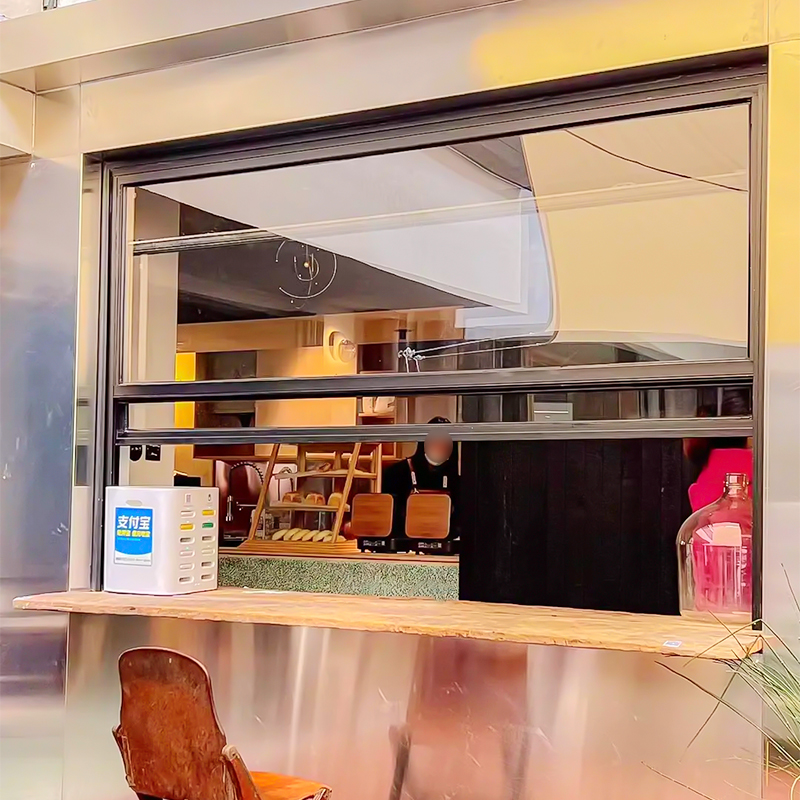Can the anti-pinch design of the manual folding window reduce safety hazards during use?
Release Time : 2025-08-14
During daily opening and closing of manual folding windows, due to the interlocking nature of their multi-sash structure, gaps between the sashes and the frame, and between the sashes, can easily create a risk of pinching fingers, posing a particular safety threat to the elderly and children. Anti-pinch design, a key safety feature of manual folding windows, effectively mitigates these safety hazards through targeted structural optimization and protective measures, ensuring greater peace of mind during use.
Anti-pinch design mitigates pinching risks at the source by optimizing the gap structure. Traditional folding windows often have wide gaps at the sash joints and between the sashes and the frame, making it easy for fingers to get trapped during opening and closing. High-quality anti-pinch design minimizes gaps in key areas, keeping them within safe limits. It also rounds edges to prevent scratches from sharp corners. Where necessary interlocking gaps are maintained, elastic cushioning strips are installed. These soft rubber or silicone materials fill the gaps, preventing any fingers from being squeezed if accidentally inserted, minimizing the risk of pinching.
Anti-pinch trigger mechanisms in interlocking areas interrupt dangerous movements promptly. Some manual folding windows are equipped with pressure sensors or mechanical stoppers at the sash joints. When the pressure detected by the window exceeds a safety threshold, damping devices slow the window sash's closing speed or trigger a reverse buffering force. For example, if a finger is pinched, the pressure sensor immediately transmits a signal, causing the linked hinge to temporarily lock or slightly rebound, providing space for the finger to escape and preventing continued pinching and injury. This active protection mechanism is more effective than passive protection alone in minimizing injury.
The anti-pinch design's buffer damping system reduces the impact of pinching. During the opening and closing of manual folding windows, the sash may close rapidly due to gravity or thrust, resulting in a significant impact if a finger is pinched. The anti-pinch design incorporates dampers at key locations, such as the hinges and rails, to automatically decelerate the window sash during the final closing phase, creating a "soft landing." This buffering effect slows the window sash's closing speed from rapid to slow, significantly reducing the impact force in the event of accidental pinching, mitigating the risk of injuries ranging from minor pain to fractures.
Edge guards enhance safety at vulnerable areas. Manual folding window sash edges and handles are high-risk areas for pinching. Anti-pinch designs incorporate protective strips or shielding structures in these areas. For example, soft anti-collision strips wrapped around the sash edge increase contact area and absorb impact through elastic material. Curved shields are placed at the connection between the handle and the sash to prevent fingers from entering the gap. These protective features act as a "safety barrier" in hazardous areas, physically isolating them from the possibility of pinching.
Child-friendly anti-pinch designs specifically reduce the risk of pinching for children. Children, with their strong curiosity and weak self-protection awareness, are a high-risk group for pinching accidents. Manual folding window anti-pinch designs are specifically designed with children in mind, employing a lower trigger sensitivity to activate even the slightest contact. Furthermore, enhanced protection is implemented at lower contact points, such as thicker cushioning or cartoon-shaped protective covers in the sash gaps within a child's height range. This enhances safety while alerting children to the dangers, doubly reducing the risk of pinching.
The durability of anti-pinch designs ensures long-term safety. Manual folding window anti-pinch components must withstand the wear and tear of frequent opening and closing. High-quality products utilize age-resistant materials for components such as buffer strips and dampers to ensure they maintain their protective performance even after long-term use. Furthermore, the interlocking anti-pinch mechanism has been tested for tens of thousands of openings and closings, ensuring it will not fail due to mechanical fatigue. This prevents safety hazards caused by component aging and ensures that the anti-pinch feature continues to function throughout the product's lifecycle.
Operational feedback enhances user safety awareness. Anti-pinch features not only provide physical protection but also convey safety signals through operational feel. For example, when a folding window with anti-pinch functionality nears its closing end, it alerts the user through a change in resistance. Some products also provide a subtle "click" or vibration to indicate when a high-risk pinch zone is approaching. This feedback mechanism helps users develop standardized operating habits, reduces the risk of pinching caused by improper operation, and further mitigates safety risks through user behavior.








